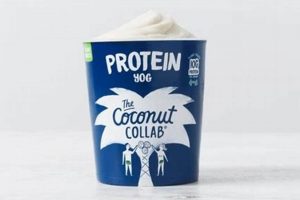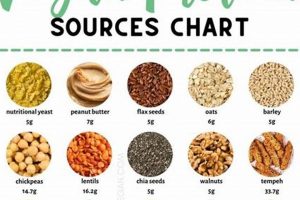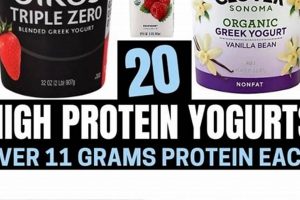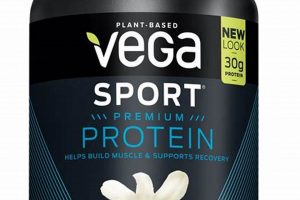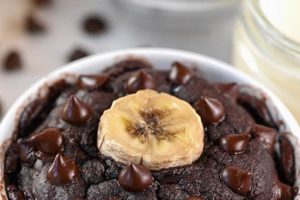Formulating plant-based patties that are rich in protein involves the combination of ingredients specifically chosen for their protein content and texture. These food items offer an alternative to traditional meat-based burgers, catering to individuals following vegetarian or vegan diets while also providing a substantial amount of protein. As an illustration, consider a preparation incorporating lentils, quinoa, and vital wheat gluten as primary ingredients, resulting in a protein-packed, meat-free burger.
The significance of developing formulas for protein-rich meat alternatives lies in addressing nutritional needs within specific dietary frameworks. These recipes serve to ensure adequate protein intake, which is essential for muscle maintenance, energy production, and overall health, especially for those who abstain from animal products. Historically, creating palatable and nutritionally complete vegan options has been a challenge; however, advances in food science and ingredient availability have led to more effective and appealing meat substitutes.
The subsequent discussion will delve into the key components and methodologies involved in crafting successful examples of these protein-focused culinary creations. It will also explore various ingredient options and preparation techniques that optimize both the nutritional profile and the sensory attributes of the final product.
Formulation Strategies
The following are recommended practices to enhance the protein content and overall quality of plant-based burger formulations.
Tip 1: Legume Incorporation: Prioritize the inclusion of legumes, such as lentils, black beans, or chickpeas, as they provide a significant source of plant-based protein and fiber. Pre-cooking and mashing these ingredients improves binding and texture.
Tip 2: Grain Selection: Incorporate grains with high protein content, such as quinoa or amaranth, to augment the protein profile. These grains also contribute essential amino acids.
Tip 3: Vital Wheat Gluten Use: Utilize vital wheat gluten as a binding agent and protein booster. It provides elasticity and structure to the burger, preventing it from crumbling during cooking. Note that this ingredient is not suitable for individuals with gluten sensitivities.
Tip 4: Seed and Nut Additions: Integrate seeds and nuts, such as chia seeds, flax seeds, or walnuts, to enhance the protein, healthy fats, and micronutrient content. These ingredients also add textural complexity.
Tip 5: Tofu or Tempeh Integration: Consider incorporating tofu or tempeh, which are complete protein sources derived from soybeans. These ingredients provide a firm texture and absorb flavors effectively.
Tip 6: Careful Seasoning: Season judiciously, utilizing herbs, spices, and umami-rich ingredients like nutritional yeast or smoked paprika to enhance the flavor profile and create a palatable product.
Tip 7: Moisture Management: Control moisture content carefully to prevent excessively dry or soggy burgers. Using a binder like flaxseed meal mixed with water can aid in moisture retention.
Adherence to these strategies contributes to the development of a plant-based burger that meets both nutritional and culinary expectations.
The article will now transition to the discussion of cooking techniques and serving suggestions to maximize the consumption experience.
1. Ingredient Selection
The selection of ingredients forms the bedrock of any attempt to produce a plant-based burger that provides a substantial protein content. The components chosen directly influence the nutritional profile, texture, and overall palatability of the final product. Thoughtful consideration must be given to the protein density, amino acid composition, and functional properties of each ingredient to achieve the desired outcome.
- Protein Source Diversity
The utilization of multiple protein sources is crucial for achieving a complete amino acid profile. Relying on a single ingredient may result in deficiencies in certain essential amino acids. A combination of legumes (e.g., lentils, black beans), grains (e.g., quinoa, amaranth), seeds (e.g., hemp seeds, chia seeds), and nuts (e.g., walnuts, almonds) can provide a more balanced array of amino acids. For instance, a burger that combines lentils and quinoa addresses the amino acid limitations of each ingredient individually.
- Binding Agents and Texture Modifiers
Selecting appropriate binding agents and texture modifiers is critical for creating a cohesive and palatable burger. Ingredients such as vital wheat gluten (for those without gluten sensitivities), ground flax seeds, or cooked and mashed sweet potato can contribute to the burger’s structure and prevent it from crumbling during cooking. The choice of binding agent impacts the overall texture, ranging from firm and chewy to soft and crumbly. Incorrect selection can lead to a burger that is either too dry or too mushy.
- Flavor Enhancers and Aromatic Compounds
Plant-based burgers often require the addition of ingredients that impart flavor and depth, mimicking the savory characteristics of meat-based products. Umami-rich ingredients like nutritional yeast, dried mushrooms, or soy sauce can enhance the overall flavor profile. Furthermore, incorporating herbs, spices, and aromatics such as garlic, onion, smoked paprika, or cumin can contribute to a more complex and satisfying taste. The appropriate selection of these elements can elevate a bland burger to a palatable and flavorful experience.
- Moisture Content Considerations
Managing moisture content is vital for achieving the desired texture and preventing the burger from becoming either too dry or too soggy. Ingredients with high water content, such as cooked vegetables, require careful balancing with dry ingredients like breadcrumbs or rolled oats. The moisture content also influences the burger’s ability to bind and retain its shape during cooking. Precise control over moisture levels is essential for achieving a burger with an optimal texture.
The successful formulation of a plant-based burger hinges on the judicious selection of ingredients. By carefully considering the protein sources, binding agents, flavor enhancers, and moisture content, one can create a nutritious and palatable product that aligns with dietary preferences and meets the nutritional needs of consumers. A poorly conceived ingredient selection will inevitably result in a substandard product, underscoring the importance of this foundational step.
2. Protein Optimization
Protein optimization, within the context of plant-based burger formulations, refers to the strategic manipulation of ingredient ratios and processing techniques to maximize the protein content and bioavailability of the final product. Its relevance stems from the need to provide a nutritionally equivalent, or superior, alternative to traditional meat-based burgers, particularly for individuals adhering to vegan or vegetarian dietary regimens.
- Ingredient Synergy and Complementary Protein Sources
This facet involves combining different plant-based protein sources to ensure a complete amino acid profile. Single plant-based proteins may be deficient in one or more essential amino acids. For example, combining legumes (rich in lysine) with grains (rich in methionine) compensates for the amino acid limitations of each, resulting in a complete protein source within the burger. The implication is a burger that provides all the essential amino acids necessary for human health, mimicking the amino acid profile of animal-based proteins.
- Protein Concentration Techniques
Protein optimization can involve the use of protein isolates or concentrates derived from plant sources like soy, peas, or rice. These concentrated protein sources significantly increase the protein density of the burger without substantially altering its texture or flavor. The incorporation of pea protein isolate, for example, can increase the protein content of a burger by several grams per serving. This approach directly impacts the burger’s nutritional value, making it a more substantial source of protein.
- Digestibility Enhancement
Raw plant-based proteins can sometimes be less digestible than animal-based proteins due to the presence of enzyme inhibitors or complex carbohydrates. Cooking or fermentation processes can improve the digestibility of these proteins. For example, pre-cooking lentils or fermenting tempeh before incorporating them into a burger can increase the bioavailability of the protein they contain. This ensures that the body can efficiently absorb and utilize the protein from the burger.
- Minimizing Protein Denaturation
Excessive heat or harsh processing methods can denature proteins, reducing their nutritional value and functionality. Optimization strategies include using gentle cooking methods, such as baking or pan-frying at moderate temperatures, and avoiding over-processing the ingredients. Maintaining the structural integrity of the protein molecules preserves their nutritional benefits and contributes to a more palatable texture. This is critical for delivering a high-quality, protein-rich vegan burger.
These facets of protein optimization are interconnected and essential for crafting a plant-based burger that not only provides a high protein content but also ensures that the protein is bioavailable, complete, and functional. Consider a burger formulated with a blend of pea protein concentrate, pre-cooked lentils, and quinoa, gently cooked to maintain protein integrity; such a product exemplifies the successful application of these principles in creating a superior plant-based alternative to traditional meat burgers.
3. Textural Integrity
Textural integrity plays a pivotal role in the consumer acceptance and overall success of any “high protein vegan burger recipe”. The absence of desirable texture can render even the most nutritionally complete and flavorful plant-based burger unappetizing. Therefore, understanding and controlling the factors that influence texture are paramount.
- Binding Agent Selection and Application
Binding agents are critical for providing structure and cohesion in the absence of animal proteins. Substances such as vital wheat gluten (for non-gluten-free applications), methylcellulose, modified food starch, or even pureed vegetables like sweet potato contribute to the burger’s ability to hold its shape during cooking and consumption. Improper use of these agents can result in a burger that is either too dense and rubbery or too soft and crumbly. For instance, excessive vital wheat gluten may produce an unpleasantly chewy texture, while insufficient binding may lead to a burger that falls apart easily.
- Moisture Management
Moisture content significantly impacts the texture of the final product. Too much moisture can lead to a soggy, mushy burger, while insufficient moisture results in a dry, crumbly texture. Balancing wet and dry ingredients is crucial. For example, ingredients like pre-cooked lentils or shredded zucchini contribute moisture, which must be offset by dry ingredients such as breadcrumbs or rolled oats. Accurate moisture control is achieved through careful ingredient selection and precise measurements.
- Particle Size Distribution
The size and distribution of particles within the burger matrix influence the overall mouthfeel. Varying the particle size of ingredients like chopped vegetables, ground nuts, or cooked grains can create a more complex and appealing texture. A burger composed entirely of finely ground ingredients may lack desirable chewiness or bite, while a burger with overly large chunks may be difficult to bind and cook evenly. Strategically incorporating a range of particle sizes enhances the sensory experience.
- Cooking Method Optimization
The cooking method significantly affects the final texture of the burger. High-heat cooking methods, such as grilling or pan-frying, can create a desirable sear and crisp exterior, while baking or steaming results in a softer texture. Overcooking can lead to a dry, tough burger, while undercooking may result in a mushy, unappetizing product. Optimizing the cooking time and temperature based on the specific ingredients and desired texture is essential.
In summation, achieving optimal textural integrity in a “high protein vegan burger recipe” necessitates careful consideration of binding agents, moisture management, particle size, and cooking methods. The successful manipulation of these factors results in a plant-based burger that is not only nutritious but also provides a satisfying and palatable eating experience. Conversely, neglecting textural considerations can undermine the overall quality and consumer appeal of the product.
4. Flavor Enhancement
Flavor enhancement is a critical component in the formulation of plant-based patties. The inherent flavor profiles of plant-derived protein sources often differ significantly from those of meat, necessitating deliberate strategies to achieve a palatable and appealing final product. The absence of effective flavor enhancement can result in a burger that lacks the savory and umami characteristics typically associated with traditional beef or poultry patties.
- Umami Incorporation
The addition of umami-rich ingredients serves to replicate the savory depth found in meat. Substances such as nutritional yeast, dried mushrooms (particularly shiitake or porcini), tomato paste, soy sauce, and miso paste contribute glutamates, which activate umami receptors on the tongue. For example, incorporating rehydrated and finely chopped dried shiitake mushrooms into a lentil-based patty can significantly enhance its savory character, offsetting the inherent earthiness of the lentils and creating a more complex flavor profile. This approach effectively compensates for the missing meat-derived glutamates.
- Herbal and Spice Blends
Strategic use of herbs and spices introduces layers of flavor and aromatic complexity. Smoked paprika, cumin, coriander, garlic powder, onion powder, and chili powder can impart warmth, depth, and a subtle smokiness, mimicking the flavors associated with grilled or roasted meat. A well-balanced blend of these elements can mask any undesirable off-flavors from plant-based protein sources. For instance, a combination of smoked paprika, garlic powder, and cumin can transform a simple black bean burger into a more flavorful and satisfying culinary experience.
- Acidic Balance
Introducing acidity helps to brighten the flavor profile and create a more dynamic taste. Lemon juice, lime juice, apple cider vinegar, or even a touch of balsamic vinegar can cut through the richness of plant-based fats and proteins, providing a necessary counterpoint. Acidic components also interact with other flavors, enhancing their perceived intensity. For example, a squeeze of lemon juice over a cooked quinoa burger can elevate its overall flavor and prevent it from tasting bland.
- Maillard Reaction Enhancement
The Maillard reaction, a chemical reaction between amino acids and reducing sugars, is responsible for the browning and flavor development that occurs during cooking. Ingredients such as maple syrup, molasses, or a small amount of sugar can promote this reaction, resulting in a richer, more caramelized flavor. The addition of these ingredients, combined with high-heat cooking methods like pan-frying or grilling, can create a desirable sear and crust on the burger, enhancing its overall palatability. This browning effect not only improves the flavor but also contributes to a more visually appealing product.
The judicious application of these flavor enhancement techniques is essential for creating a plant-based burger that is both nutritionally sound and gastronomically satisfying. A poorly flavored burger, regardless of its protein content, is unlikely to appeal to a broad audience. The strategic incorporation of umami, herbs, spices, acidity, and Maillard reaction enhancers is crucial for bridging the flavor gap between plant-based alternatives and traditional meat-based burgers, increasing consumer acceptance and promoting the adoption of more sustainable dietary choices.
5. Nutritional Completeness
Nutritional completeness, in the context of a high protein, plant-based burger formulation, is not simply about achieving a high protein content. It encompasses the delivery of a comprehensive array of essential nutrients necessary for maintaining optimal health. A well-formulated product must provide adequate quantities of vitamins, minerals, essential fatty acids, and fiber, alongside its protein content, to function as a viable and healthful dietary option.
- Amino Acid Profiling
Achieving a complete amino acid profile is crucial, as plant-based protein sources may be limiting in certain essential amino acids. Lysine, methionine, and tryptophan are often of particular concern. Formulating the patty with a combination of protein sources, such as legumes and grains, can compensate for individual amino acid deficiencies and provide a complete protein source comparable to animal products. Failure to address amino acid deficiencies can result in suboptimal protein synthesis and impaired physiological function.
- Micronutrient Fortification
Plant-based diets can sometimes be lower in certain micronutrients, such as vitamin B12, iron, calcium, and zinc. Supplementation or fortification of the burger with these nutrients is necessary to ensure nutritional adequacy. For example, incorporating ingredients like nutritional yeast (rich in B vitamins) or iron-fortified grains can improve the micronutrient profile. Neglecting micronutrient considerations can lead to deficiencies and associated health consequences.
- Essential Fatty Acid Provision
Ensuring an adequate intake of essential fatty acids, particularly omega-3 and omega-6 fatty acids, is important for overall health. Incorporating ingredients like flax seeds, chia seeds, or walnuts can provide these essential fats. Balancing the ratio of omega-3 to omega-6 fatty acids is also crucial, as an imbalance can contribute to inflammation. The inclusion of these fatty acids enhances the nutritional value of the burger beyond its protein content.
- Fiber Content Optimization
Dietary fiber is essential for digestive health, blood sugar regulation, and satiety. Plant-based burgers offer an opportunity to deliver a significant amount of fiber through the inclusion of ingredients like beans, lentils, vegetables, and whole grains. Optimizing the fiber content can improve the burger’s overall nutritional profile and contribute to feelings of fullness, potentially aiding in weight management. Insufficient fiber intake is a common dietary concern that can be addressed through careful formulation of plant-based burgers.
The nutritional completeness of a high protein vegan burger extends beyond simply providing a substantial quantity of protein. It necessitates a holistic approach to nutrient delivery, encompassing amino acids, micronutrients, essential fatty acids, and fiber. A thoughtfully formulated product addresses potential nutrient deficiencies associated with plant-based diets and offers a convenient and healthful alternative to traditional meat-based burgers. Overlooking any of these nutritional aspects diminishes the overall value and potential health benefits of the plant-based burger.
Frequently Asked Questions
The following addresses common inquiries regarding the formulation, nutritional value, and preparation of plant-based burgers intended to deliver a substantial protein yield.
Question 1: What constitutes a “high protein” content in a vegan burger?
A “high protein” designation for a vegan burger generally implies a protein content exceeding 15 grams per serving. This threshold aims to provide a nutritionally significant protein source comparable to many meat-based alternatives.
Question 2: Are commercially available “high protein vegan burger recipes” nutritionally complete?
The nutritional completeness of commercially available options varies significantly. Scrutinizing the nutrition facts label is advisable to assess the presence of essential amino acids, vitamins (particularly B12), and minerals (such as iron and zinc). Some formulations may require supplementation from other dietary sources.
Question 3: Can homemade versions effectively replicate the texture and flavor of meat-based burgers?
Achieving a meat-like texture and flavor in homemade versions is possible with careful ingredient selection and preparation techniques. Utilizing ingredients such as vital wheat gluten (for those without gluten sensitivities), incorporating umami-rich components (e.g., mushrooms, nutritional yeast), and employing appropriate cooking methods contribute to a more satisfying sensory experience.
Question 4: What are the primary protein sources used in these recipes?
Common protein sources include legumes (lentils, beans), grains (quinoa, amaranth), seeds (hemp, chia), nuts, and soy-based products (tofu, tempeh). Combinations of these sources are often employed to ensure a complete amino acid profile.
Question 5: Do these recipes require specialized equipment or ingredients?
Most recipes can be prepared with standard kitchen equipment. While certain ingredients, such as vital wheat gluten or specific protein isolates, may require purchase from specialty stores or online retailers, readily available alternatives can often be substituted.
Question 6: How can the fiber content of these burgers be further enhanced?
Increasing the proportion of fiber-rich ingredients, such as beans, lentils, vegetables, and whole grains, enhances the fiber content. Incorporating flax seeds or chia seeds also provides a significant fiber boost.
In summary, high-protein plant-based burgers offer a viable alternative to traditional meat-based options, provided that careful attention is paid to nutritional completeness, flavor enhancement, and textural integrity. Both commercially available and homemade versions can contribute to a healthful and sustainable dietary pattern.
The subsequent section will transition to a discussion of recipe variations and customization options.
High Protein Vegan Burger Recipe
This exploration has elucidated the complexities inherent in crafting a satisfying and nutritionally complete plant-based burger that delivers a substantial protein yield. Key considerations include strategic ingredient selection, protein optimization through complementary sources, meticulous attention to textural integrity, and the skillful application of flavor enhancement techniques. The imperative of achieving nutritional completeness, encompassing essential amino acids, micronutrients, and adequate fiber, has also been underscored.
The information presented herein provides a foundation for informed decision-making regarding plant-based dietary choices. Continued innovation and refinement of formulations are essential to meeting the evolving needs of consumers seeking sustainable and healthful alternatives to traditional meat products. The pursuit of optimal nutrition and palatability remains paramount in the ongoing development of high protein vegan burger recipes.


